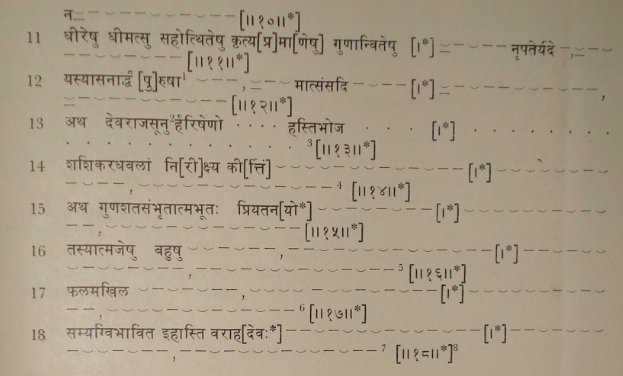|
INSCRIPTIONS OF THE MINISTERS AND FEUDATORIES OF THE
VATSAGULMA BRANCH

TRANSLATION9
...(Verse 1). Victorious is he who is called the Buddha, the sage among sages, the teacher
among teachers, the immortal among immortals, the best among the eminent (and) a store
of marvels−who attained enlightenment by abstension from the enjoyment10 (of worldly
pleasures).
...(V. 2). (Victorious) next (is) the law promulgated by him who knows the law; and (victorious) also (is) the Community, the best among all communities, having done service
to which11, a worthy recipient, the sons (of men) become exalted.
_____________________
1 Bhagvanlal read पुरुषा, but bühler took the word to be सुरसा. The aksharas are doubtful, but
I have followed Bhagvanlal as the traces left admit of that reading.
2 Bhagvanlal could read only देवराज, and Bühler देवराजस्य .The akshara following देवराज is
clearly स. The next akshara has lost its upper part, but the lower u-sign is clear. The following akshara is clearly ha. It closely resembles ha in महद्भिः, line 3. The next akshara is almost certainly ri. The name was undoubtedly हरिषेणो, the last two aksharas being clear in the new estampages. As the
previous editors missed this important name, they were unable to identify this Dēvarāja correctly.
3 Metre: Āryā.
4 Netre of verses 14 and 15: Pushpitāgrā.
5 Metre: Vasantatilakā.
6 Metre: Pushpitāgrā.
7 Metre: Vasantatilakā.
8There are traces of an akshara here and there in the next four lines in the lithograph published in A.S.W.I., Vol. IV, Pl. LX as well as in the estampages supplied to me, but no words can be read completely.
9 In this translation I have derived some help from Dr. Bühler’s rendering. though I have differed
from him in the interpretation of several passages.
10 Anābhōga is ‘lack of attention or interest, disinclination’. See A Critical Palī Dictionary by
Trenckner, Anderson and smith. Bühler translates it as ‘abstaining from fruition’.
11 the sense of the second half of this verse is somewhat obscure. Kāra seems to be used herein the
same sense as in Pali, viz., a deed, Service, act of mercy or worship, homage. Kārāpakāra is apparently
used here in the same sense as Kārakāraka ‘ one who performs a religious duty or service’. (Pali Dictionary
by Rhys Davids). Kārā has been used in line 17 of No. 25 above. See p. 111, n. 1, above, this
(Continued)
|